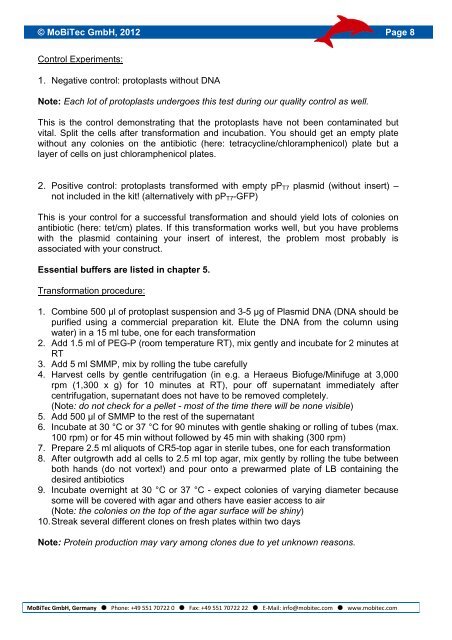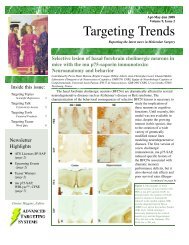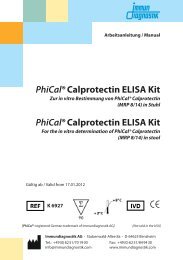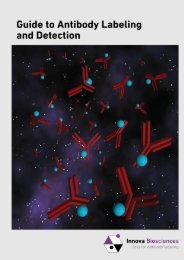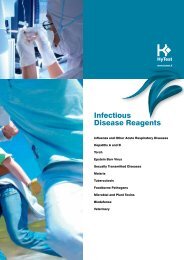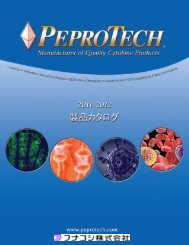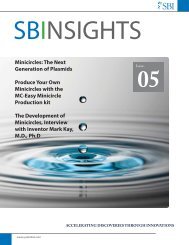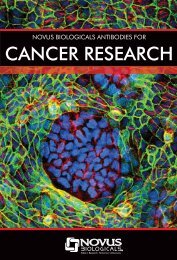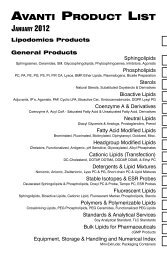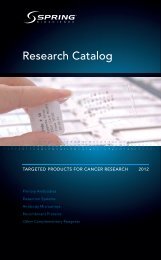T7 RNA Polymerase Expression System for Bacillus megaterium
T7 RNA Polymerase Expression System for Bacillus megaterium
T7 RNA Polymerase Expression System for Bacillus megaterium
You also want an ePaper? Increase the reach of your titles
YUMPU automatically turns print PDFs into web optimized ePapers that Google loves.
© MoBiTec GmbH, 2012 Page 8<br />
Control Experiments:<br />
1. Negative control: protoplasts without DNA<br />
Note: Each lot of protoplasts undergoes this test during our quality control as well.<br />
This is the control demonstrating that the protoplasts have not been contaminated but<br />
vital. Split the cells after trans<strong>for</strong>mation and incubation. You should get an empty plate<br />
without any colonies on the antibiotic (here: tetracycline/chloramphenicol) plate but a<br />
layer of cells on just chloramphenicol plates.<br />
2. Positive control: protoplasts trans<strong>for</strong>med with empty pP<strong>T7</strong> plasmid (without insert) –<br />
not included in the kit! (alternatively with pP<strong>T7</strong>-GFP)<br />
This is your control <strong>for</strong> a successful trans<strong>for</strong>mation and should yield lots of colonies on<br />
antibiotic (here: tet/cm) plates. If this trans<strong>for</strong>mation works well, but you have problems<br />
with the plasmid containing your insert of interest, the problem most probably is<br />
associated with your construct.<br />
Essential buffers are listed in chapter 5.<br />
Trans<strong>for</strong>mation procedure:<br />
1. Combine 500 μl of protoplast suspension and 3-5 μg of Plasmid DNA (DNA should be<br />
purified using a commercial preparation kit. Elute the DNA from the column using<br />
water) in a 15 ml tube, one <strong>for</strong> each trans<strong>for</strong>mation<br />
2. Add 1.5 ml of PEG-P (room temperature RT), mix gently and incubate <strong>for</strong> 2 minutes at<br />
RT<br />
3. Add 5 ml SMMP, mix by rolling the tube carefully<br />
4. Harvest cells by gentle centrifugation (in e.g. a Heraeus Biofuge/Minifuge at 3,000<br />
rpm (1,300 x g) <strong>for</strong> 10 minutes at RT), pour off supernatant immediately after<br />
centrifugation, supernatant does not have to be removed completely.<br />
(Note: do not check <strong>for</strong> a pellet - most of the time there will be none visible)<br />
5. Add 500 μl of SMMP to the rest of the supernatant<br />
6. Incubate at 30 °C or 37 °C <strong>for</strong> 90 minutes with gentle shaking or rolling of tubes (max.<br />
100 rpm) or <strong>for</strong> 45 min without followed by 45 min with shaking (300 rpm)<br />
7. Prepare 2.5 ml aliquots of CR5-top agar in sterile tubes, one <strong>for</strong> each trans<strong>for</strong>mation<br />
8. After outgrowth add al cells to 2.5 ml top agar, mix gently by rolling the tube between<br />
both hands (do not vortex!) and pour onto a prewarmed plate of LB containing the<br />
desired antibiotics<br />
9. Incubate overnight at 30 °C or 37 °C - expect colonies of varying diameter because<br />
some will be covered with agar and others have easier access to air<br />
(Note: the colonies on the top of the agar surface will be shiny)<br />
10.Streak several different clones on fresh plates within two days<br />
Note: Protein production may vary among clones due to yet unknown reasons.<br />
MoBiTec GmbH, Germany � Phone: +49 551 70722 0 � Fax: +49 551 70722 22 � E-Mail: info@mobitec.com � www.mobitec.com


